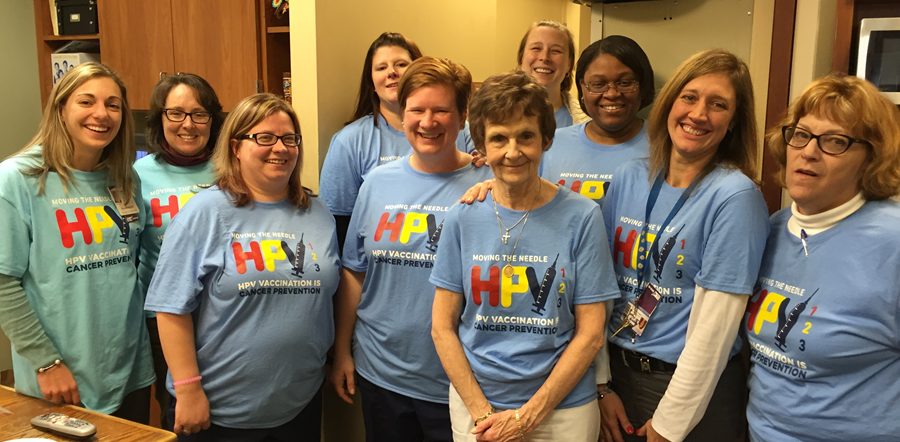Engaging your Practice Team
Improving HPV vaccination requires a team approach. The CDC has resources for educating your entire practice team about the vaccine.

— Ann McGaffey, MD, FAAFP, Medical Director, UPMC St. Margaret Bloomfield Garfield Family Health Center
Clinic Workflow
Detailed below are examples of process improvements implemented by regional champions to increase HPV vaccination. The AAP Online Learning Center also has a one-hour online course, Adolescent Immunizations: Office Strategies, with information about process changes to increase immunization (qualifies for 1 AMA PRA Category 1 Credit).
HPV Cancer Prevention Postcards: The postcard includes CDC guidelines for adolescent vaccinations on one side, and regional coverage data on the other. There is a perforated portion of the card for parents to indicate whether they are ready to start the vaccine series, or have additional questions. In the waiting room, parents can indicate their readiness to have their child vaccinated. The intent of the card is to facilitate a conversation between parents and providers about the vaccine.
Using the card requires engagement from medical records staff, medical assistants, nurses, and physicians. Engage your practice team in developing a process map for introducing the cards and tracking parental responses. An example process map, can be accessed here.
‘Blanket’ Informed Consent Forms: One challenge to HPV vaccination is completion of the series. Obtaining consent from parents or guardians for children to receive all doses in the series at the same time as consent for the first dose eliminates a barrier to vaccination. If the parent is unable to attend the follow-up appointment, the patient can still complete the series.
Standing Orders allow trained staff, especially nurses, to give the vaccine. Standing Orders reduce the time spent ordering the vaccine by physicians, ensure that the entire care team is responsible for giving the vaccine, and reduce missed opportunities.
Reminder-Recall Systems ensure that patients who initiate the HPV vaccine complete the series. Reminder systems track future appointments, whereas recall systems track missed appointments during which immunizations would have been given. American Academy of Pediatrics (AAP) resources about reminder recall systems are available here.
Tracking your Progress
Routinely tracking HPV vaccination is key to identifying opportunities for improvement and determining whether process changes are making an impact.
The National Committee for Quality Assurance (NCQA) Healthcare Effectiveness Data and Information Set (HEDIS1) is the most widely used performance measurement in healthcare. The technical specifications for the 2017 edition of HEDIS include a change to the adolescent vaccine measures. The two existing measures, HPV vaccination in females and Tdap and MCV for all adolescents, will be combined into a single measure that reports receipt of all recommended vaccines (meningococcal, Tdap, HPV) for female and male adolescents.
Quality improvement measures, such as completion of the vaccine series; number of shots administered at organizational, practice, and individual provider levels; and vaccine-related adverse events, can be defined by a practice team and tracked throughout implementation of your improvement project. Example quality improvement measures, including details about calculation and example targets are available here.
Case Studies
Regional champions developed several strategies to engage practice teams in improvement efforts. Check out practice-based case studies for more information:
- Premier Medical Associates Penn Hills Pediatric Practice: HPV Vaccination as Cancer Prevention
- UPMC St. Margaret Bloomfield-Garfield Family Health Center: A Sensational HPV Trial

